Mlango Kubwa Informal Settlement: An Urban Planning Case Study
VerifiedAdded on 2023/03/30
|12
|2100
|158
Case Study
AI Summary
This case study delves into the complexities of urban and regional planning in Nairobi, Kenya, focusing on the proliferation of informal settlements due to rapid urbanization and inadequate housing solutions. It highlights the historical context, tracing the roots of these settlements back to colonial-era segregation and post-independence policies. The study examines the challenges faced by residents, including poverty, lack of basic services, and inadequate governance. It also analyzes the top-down planning approaches that have historically failed to address the needs of low-income communities. A specific case study of the Mlango Kubwa informal settlement illustrates the severe planning problems, such as inaccessibility, pollution, and lack of essential facilities. The study concludes by emphasizing the importance of addressing these issues to improve the livability and sustainability of Nairobi's informal settlements, suggesting planning interventions and policy recommendations for long-term improvement. Desklib offers this case study along with a wealth of resources including past papers and solved assignments to aid students in their studies.
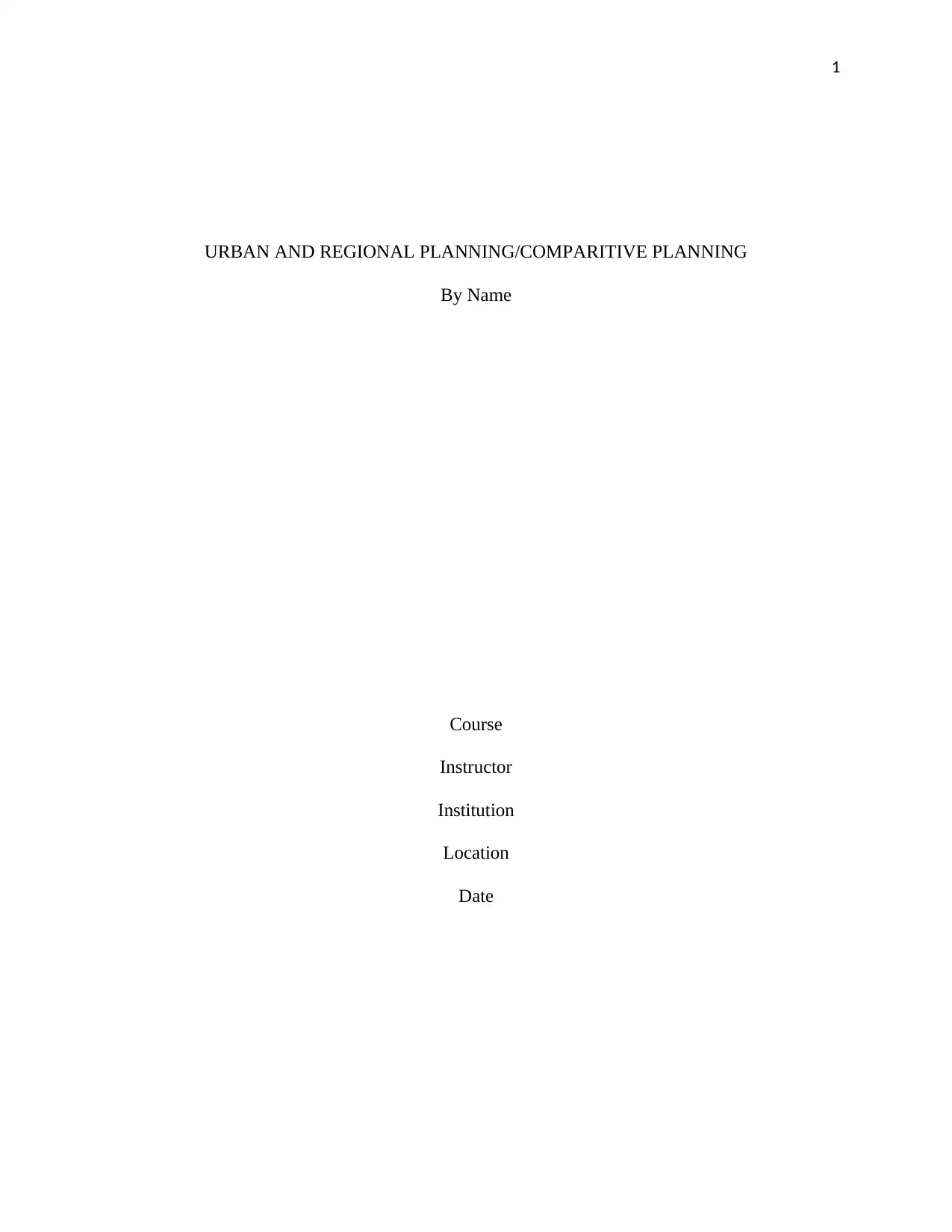
1
URBAN AND REGIONAL PLANNING/COMPARITIVE PLANNING
By Name
Course
Instructor
Institution
Location
Date
URBAN AND REGIONAL PLANNING/COMPARITIVE PLANNING
By Name
Course
Instructor
Institution
Location
Date
Paraphrase This Document
Need a fresh take? Get an instant paraphrase of this document with our AI Paraphraser
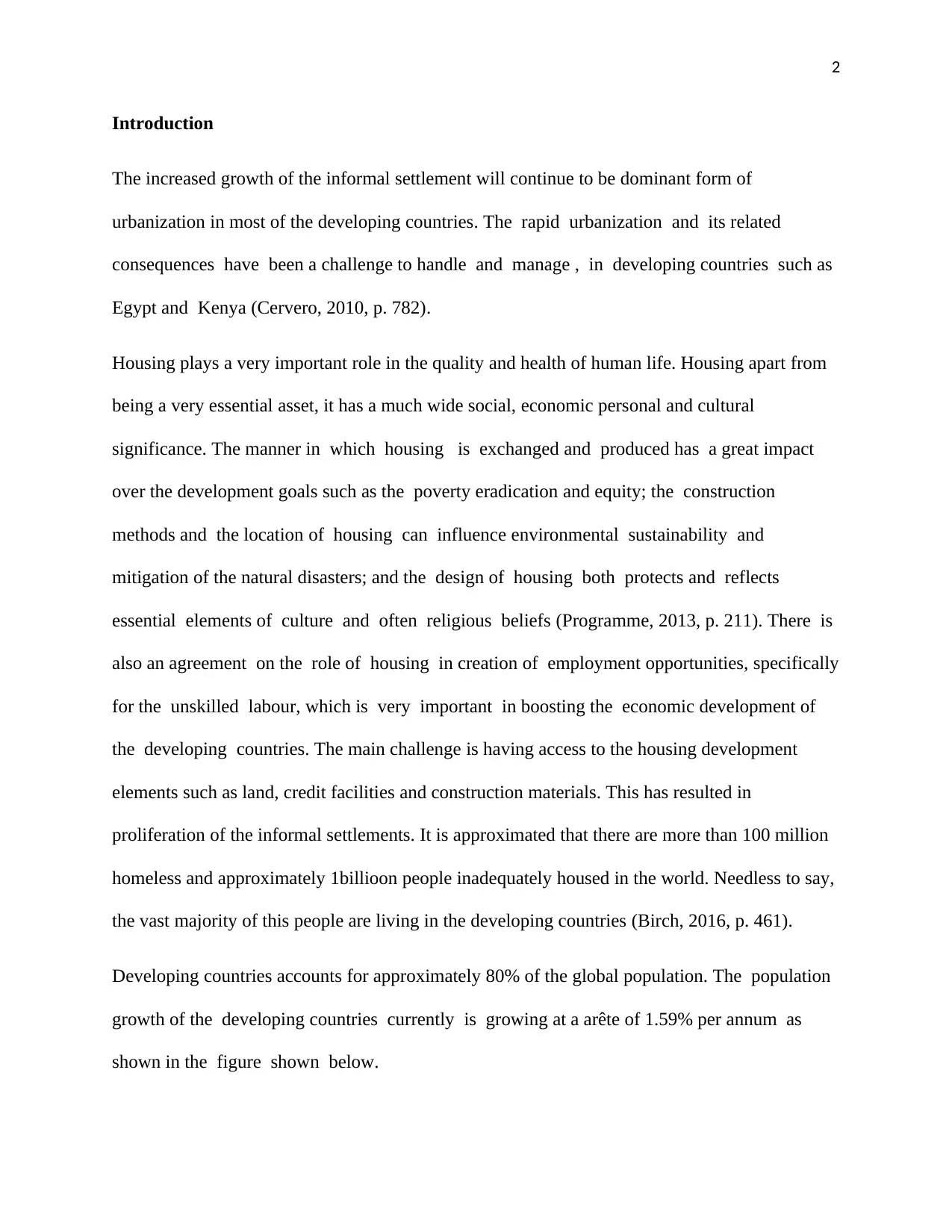
2
Introduction
The increased growth of the informal settlement will continue to be dominant form of
urbanization in most of the developing countries. The rapid urbanization and its related
consequences have been a challenge to handle and manage , in developing countries such as
Egypt and Kenya (Cervero, 2010, p. 782).
Housing plays a very important role in the quality and health of human life. Housing apart from
being a very essential asset, it has a much wide social, economic personal and cultural
significance. The manner in which housing is exchanged and produced has a great impact
over the development goals such as the poverty eradication and equity; the construction
methods and the location of housing can influence environmental sustainability and
mitigation of the natural disasters; and the design of housing both protects and reflects
essential elements of culture and often religious beliefs (Programme, 2013, p. 211). There is
also an agreement on the role of housing in creation of employment opportunities, specifically
for the unskilled labour, which is very important in boosting the economic development of
the developing countries. The main challenge is having access to the housing development
elements such as land, credit facilities and construction materials. This has resulted in
proliferation of the informal settlements. It is approximated that there are more than 100 million
homeless and approximately 1billioon people inadequately housed in the world. Needless to say,
the vast majority of this people are living in the developing countries (Birch, 2016, p. 461).
Developing countries accounts for approximately 80% of the global population. The population
growth of the developing countries currently is growing at a arête of 1.59% per annum as
shown in the figure shown below.
Introduction
The increased growth of the informal settlement will continue to be dominant form of
urbanization in most of the developing countries. The rapid urbanization and its related
consequences have been a challenge to handle and manage , in developing countries such as
Egypt and Kenya (Cervero, 2010, p. 782).
Housing plays a very important role in the quality and health of human life. Housing apart from
being a very essential asset, it has a much wide social, economic personal and cultural
significance. The manner in which housing is exchanged and produced has a great impact
over the development goals such as the poverty eradication and equity; the construction
methods and the location of housing can influence environmental sustainability and
mitigation of the natural disasters; and the design of housing both protects and reflects
essential elements of culture and often religious beliefs (Programme, 2013, p. 211). There is
also an agreement on the role of housing in creation of employment opportunities, specifically
for the unskilled labour, which is very important in boosting the economic development of
the developing countries. The main challenge is having access to the housing development
elements such as land, credit facilities and construction materials. This has resulted in
proliferation of the informal settlements. It is approximated that there are more than 100 million
homeless and approximately 1billioon people inadequately housed in the world. Needless to say,
the vast majority of this people are living in the developing countries (Birch, 2016, p. 461).
Developing countries accounts for approximately 80% of the global population. The population
growth of the developing countries currently is growing at a arête of 1.59% per annum as
shown in the figure shown below.
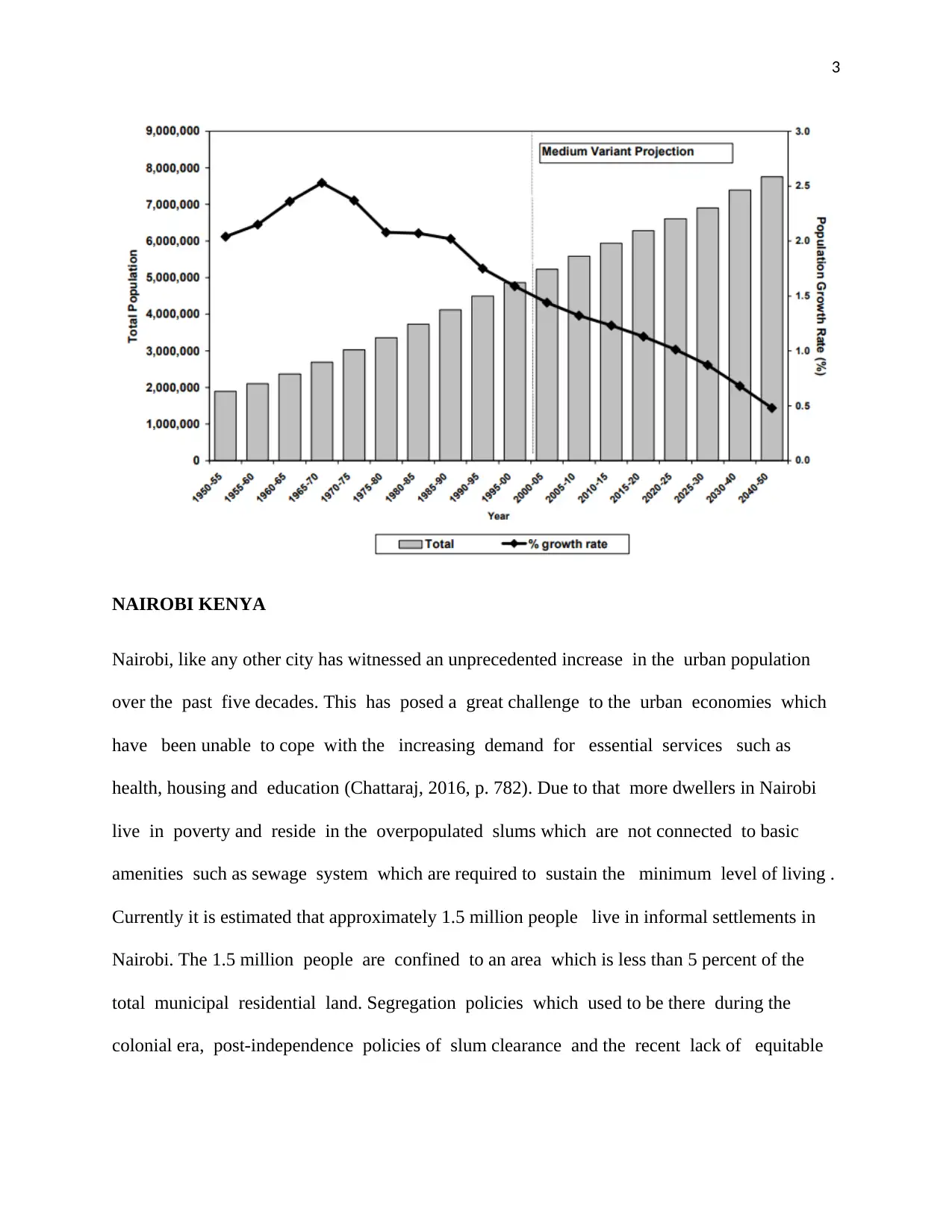
3
NAIROBI KENYA
Nairobi, like any other city has witnessed an unprecedented increase in the urban population
over the past five decades. This has posed a great challenge to the urban economies which
have been unable to cope with the increasing demand for essential services such as
health, housing and education (Chattaraj, 2016, p. 782). Due to that more dwellers in Nairobi
live in poverty and reside in the overpopulated slums which are not connected to basic
amenities such as sewage system which are required to sustain the minimum level of living .
Currently it is estimated that approximately 1.5 million people live in informal settlements in
Nairobi. The 1.5 million people are confined to an area which is less than 5 percent of the
total municipal residential land. Segregation policies which used to be there during the
colonial era, post-independence policies of slum clearance and the recent lack of equitable
NAIROBI KENYA
Nairobi, like any other city has witnessed an unprecedented increase in the urban population
over the past five decades. This has posed a great challenge to the urban economies which
have been unable to cope with the increasing demand for essential services such as
health, housing and education (Chattaraj, 2016, p. 782). Due to that more dwellers in Nairobi
live in poverty and reside in the overpopulated slums which are not connected to basic
amenities such as sewage system which are required to sustain the minimum level of living .
Currently it is estimated that approximately 1.5 million people live in informal settlements in
Nairobi. The 1.5 million people are confined to an area which is less than 5 percent of the
total municipal residential land. Segregation policies which used to be there during the
colonial era, post-independence policies of slum clearance and the recent lack of equitable
⊘ This is a preview!⊘
Do you want full access?
Subscribe today to unlock all pages.

Trusted by 1+ million students worldwide
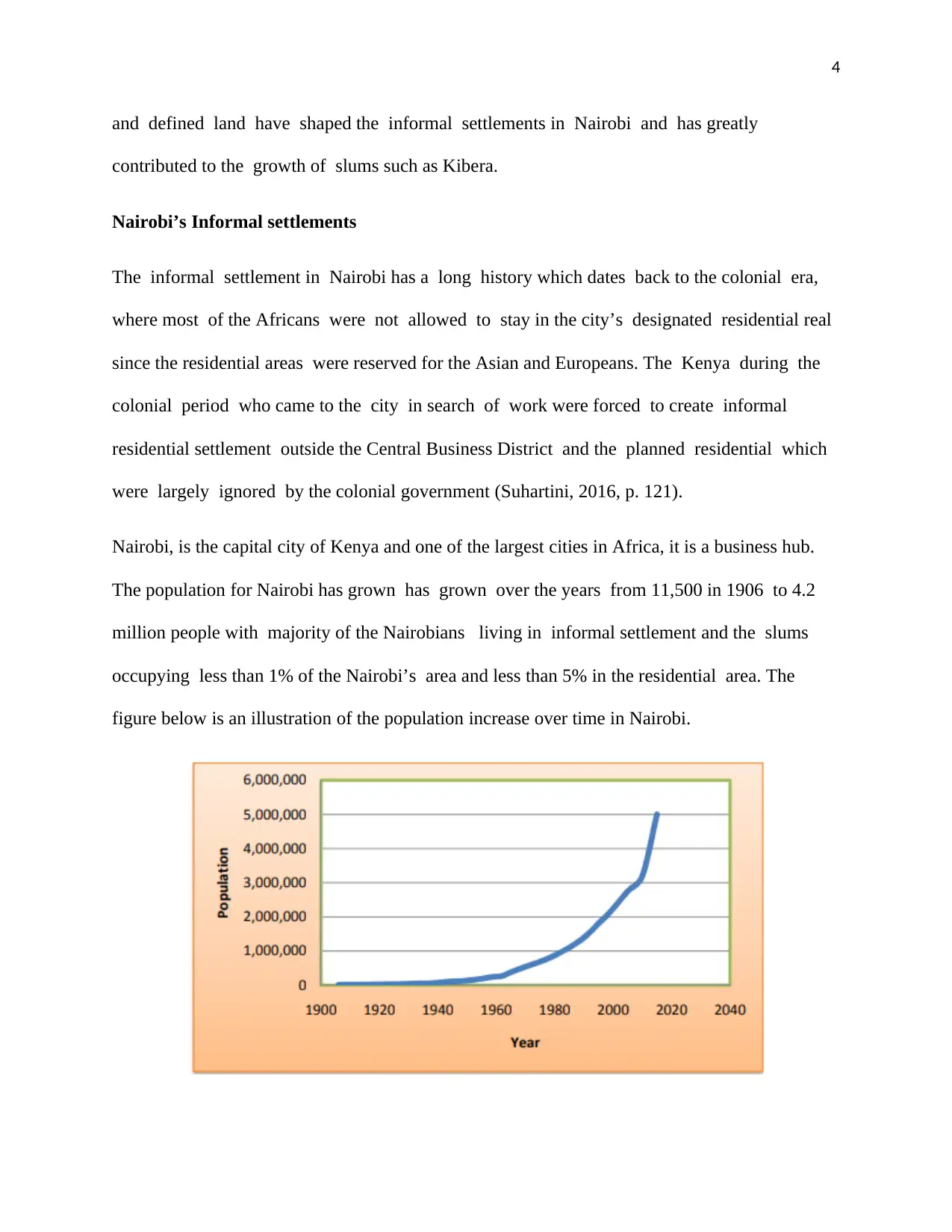
4
and defined land have shaped the informal settlements in Nairobi and has greatly
contributed to the growth of slums such as Kibera.
Nairobi’s Informal settlements
The informal settlement in Nairobi has a long history which dates back to the colonial era,
where most of the Africans were not allowed to stay in the city’s designated residential real
since the residential areas were reserved for the Asian and Europeans. The Kenya during the
colonial period who came to the city in search of work were forced to create informal
residential settlement outside the Central Business District and the planned residential which
were largely ignored by the colonial government (Suhartini, 2016, p. 121).
Nairobi, is the capital city of Kenya and one of the largest cities in Africa, it is a business hub.
The population for Nairobi has grown has grown over the years from 11,500 in 1906 to 4.2
million people with majority of the Nairobians living in informal settlement and the slums
occupying less than 1% of the Nairobi’s area and less than 5% in the residential area. The
figure below is an illustration of the population increase over time in Nairobi.
and defined land have shaped the informal settlements in Nairobi and has greatly
contributed to the growth of slums such as Kibera.
Nairobi’s Informal settlements
The informal settlement in Nairobi has a long history which dates back to the colonial era,
where most of the Africans were not allowed to stay in the city’s designated residential real
since the residential areas were reserved for the Asian and Europeans. The Kenya during the
colonial period who came to the city in search of work were forced to create informal
residential settlement outside the Central Business District and the planned residential which
were largely ignored by the colonial government (Suhartini, 2016, p. 121).
Nairobi, is the capital city of Kenya and one of the largest cities in Africa, it is a business hub.
The population for Nairobi has grown has grown over the years from 11,500 in 1906 to 4.2
million people with majority of the Nairobians living in informal settlement and the slums
occupying less than 1% of the Nairobi’s area and less than 5% in the residential area. The
figure below is an illustration of the population increase over time in Nairobi.
Paraphrase This Document
Need a fresh take? Get an instant paraphrase of this document with our AI Paraphraser
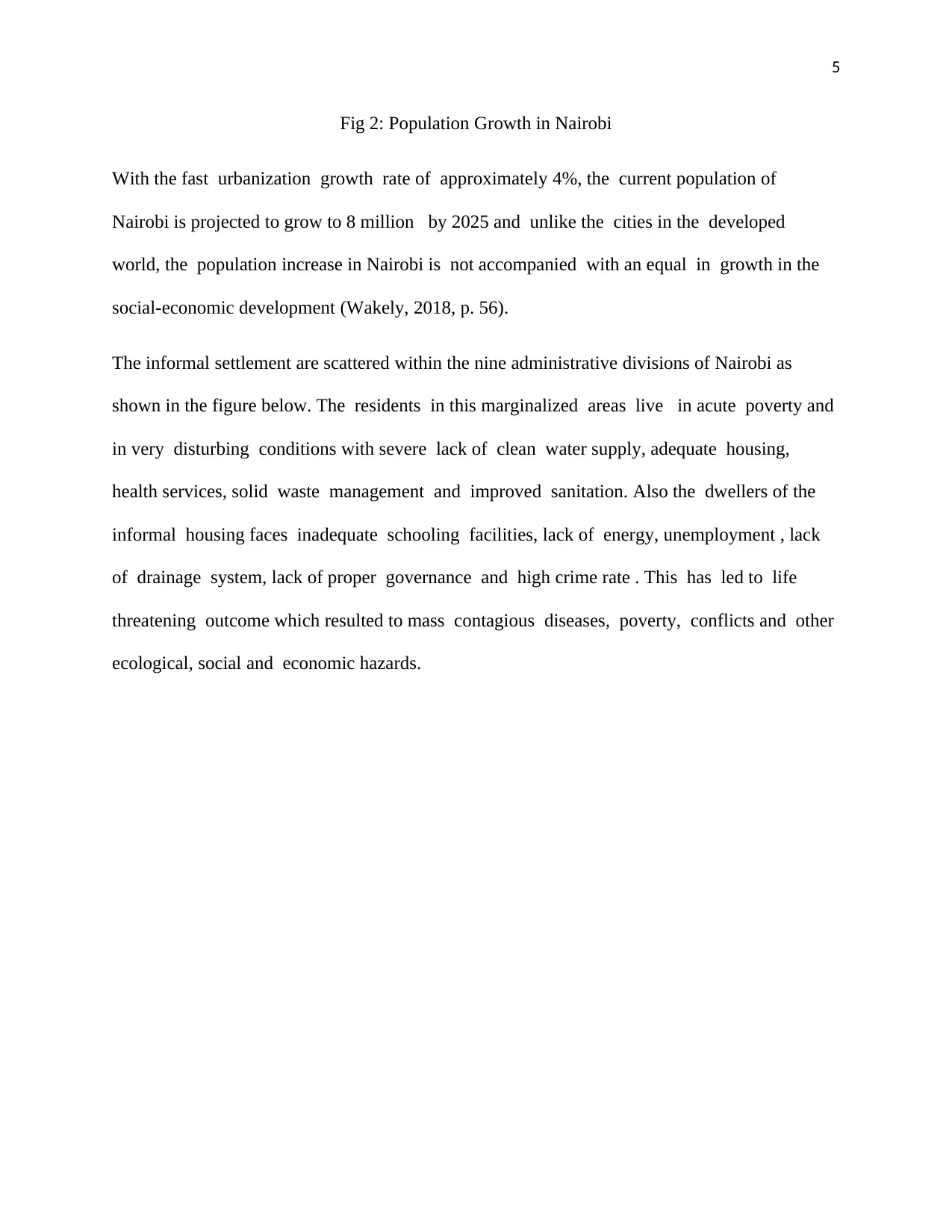
5
Fig 2: Population Growth in Nairobi
With the fast urbanization growth rate of approximately 4%, the current population of
Nairobi is projected to grow to 8 million by 2025 and unlike the cities in the developed
world, the population increase in Nairobi is not accompanied with an equal in growth in the
social-economic development (Wakely, 2018, p. 56).
The informal settlement are scattered within the nine administrative divisions of Nairobi as
shown in the figure below. The residents in this marginalized areas live in acute poverty and
in very disturbing conditions with severe lack of clean water supply, adequate housing,
health services, solid waste management and improved sanitation. Also the dwellers of the
informal housing faces inadequate schooling facilities, lack of energy, unemployment , lack
of drainage system, lack of proper governance and high crime rate . This has led to life
threatening outcome which resulted to mass contagious diseases, poverty, conflicts and other
ecological, social and economic hazards.
Fig 2: Population Growth in Nairobi
With the fast urbanization growth rate of approximately 4%, the current population of
Nairobi is projected to grow to 8 million by 2025 and unlike the cities in the developed
world, the population increase in Nairobi is not accompanied with an equal in growth in the
social-economic development (Wakely, 2018, p. 56).
The informal settlement are scattered within the nine administrative divisions of Nairobi as
shown in the figure below. The residents in this marginalized areas live in acute poverty and
in very disturbing conditions with severe lack of clean water supply, adequate housing,
health services, solid waste management and improved sanitation. Also the dwellers of the
informal housing faces inadequate schooling facilities, lack of energy, unemployment , lack
of drainage system, lack of proper governance and high crime rate . This has led to life
threatening outcome which resulted to mass contagious diseases, poverty, conflicts and other
ecological, social and economic hazards.
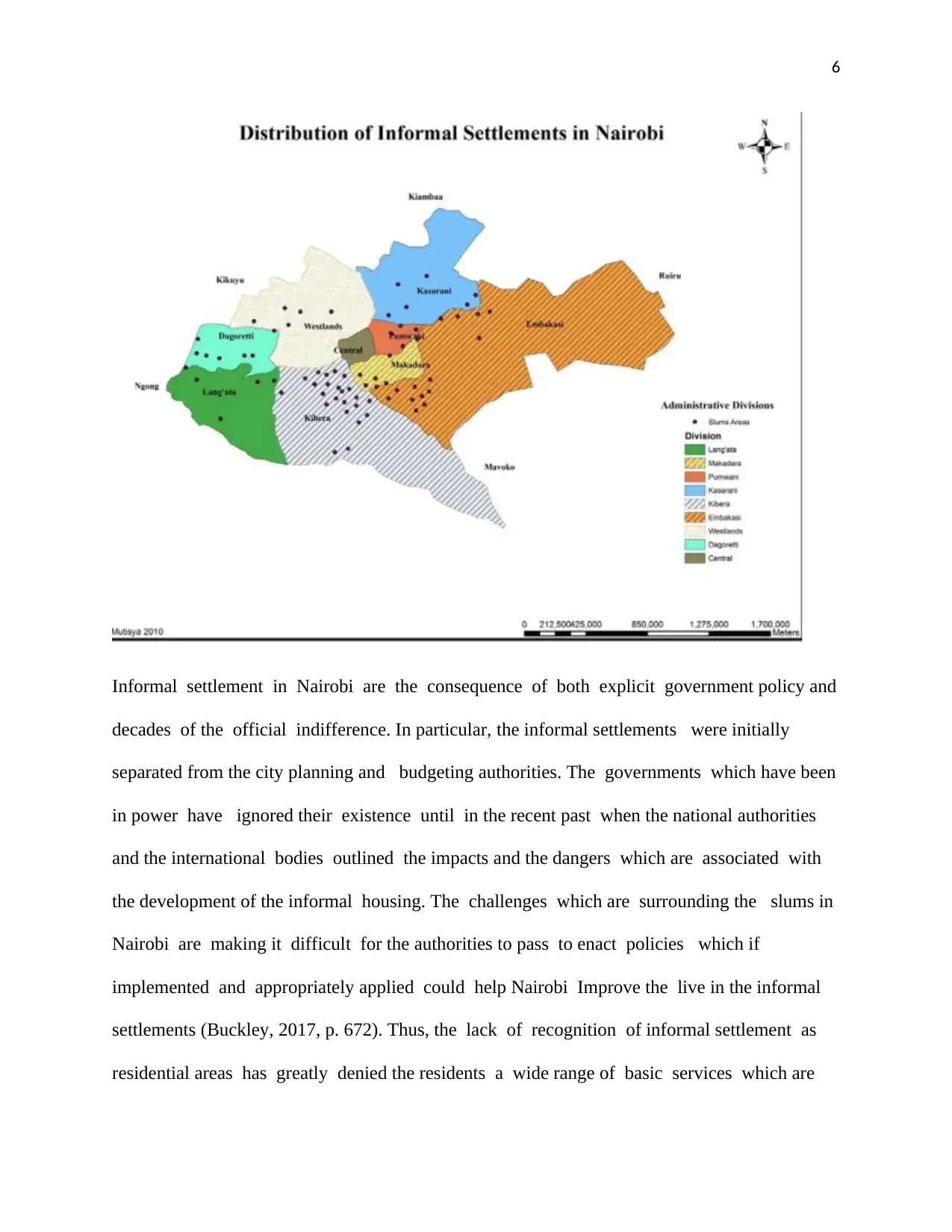
6
Informal settlement in Nairobi are the consequence of both explicit government policy and
decades of the official indifference. In particular, the informal settlements were initially
separated from the city planning and budgeting authorities. The governments which have been
in power have ignored their existence until in the recent past when the national authorities
and the international bodies outlined the impacts and the dangers which are associated with
the development of the informal housing. The challenges which are surrounding the slums in
Nairobi are making it difficult for the authorities to pass to enact policies which if
implemented and appropriately applied could help Nairobi Improve the live in the informal
settlements (Buckley, 2017, p. 672). Thus, the lack of recognition of informal settlement as
residential areas has greatly denied the residents a wide range of basic services which are
Informal settlement in Nairobi are the consequence of both explicit government policy and
decades of the official indifference. In particular, the informal settlements were initially
separated from the city planning and budgeting authorities. The governments which have been
in power have ignored their existence until in the recent past when the national authorities
and the international bodies outlined the impacts and the dangers which are associated with
the development of the informal housing. The challenges which are surrounding the slums in
Nairobi are making it difficult for the authorities to pass to enact policies which if
implemented and appropriately applied could help Nairobi Improve the live in the informal
settlements (Buckley, 2017, p. 672). Thus, the lack of recognition of informal settlement as
residential areas has greatly denied the residents a wide range of basic services which are
⊘ This is a preview!⊘
Do you want full access?
Subscribe today to unlock all pages.

Trusted by 1+ million students worldwide
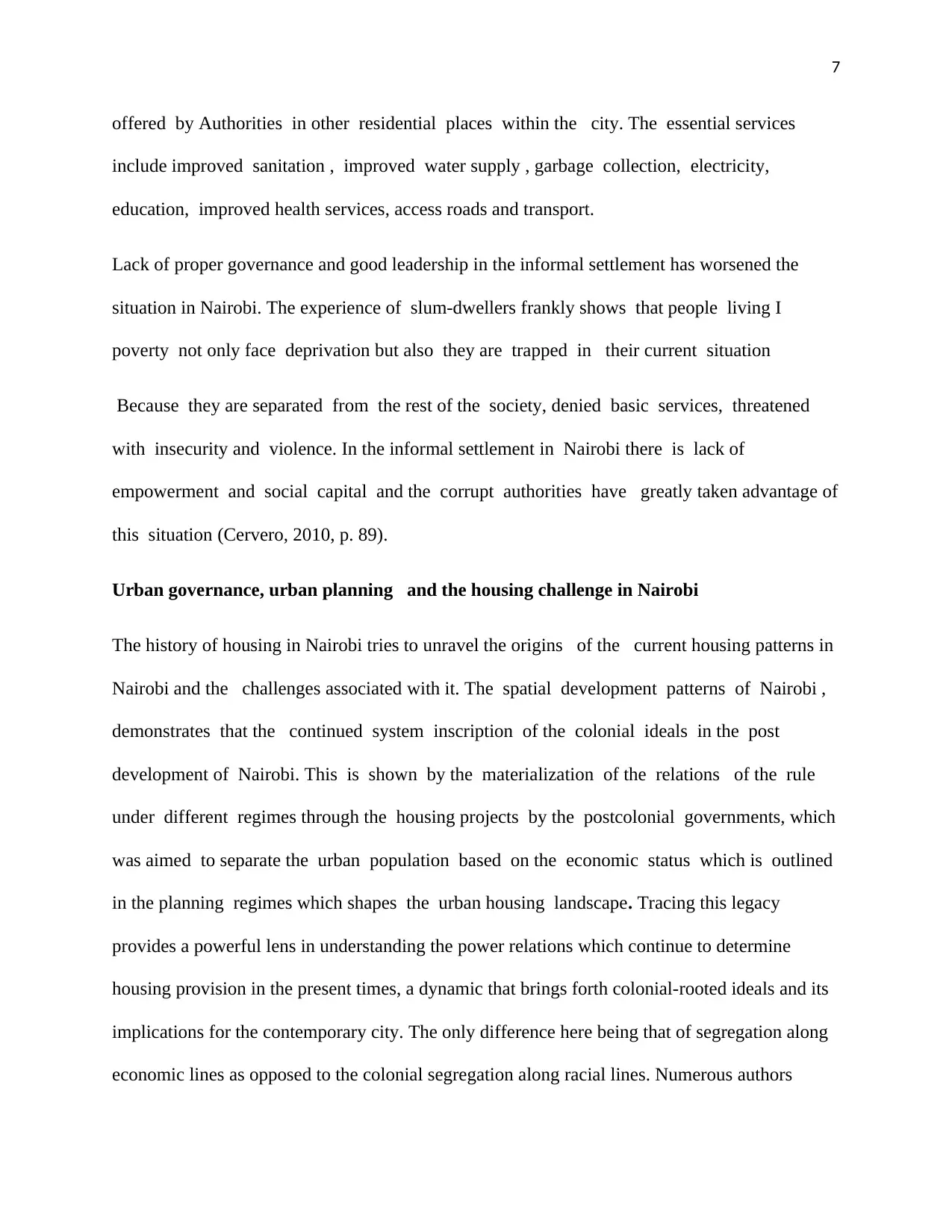
7
offered by Authorities in other residential places within the city. The essential services
include improved sanitation , improved water supply , garbage collection, electricity,
education, improved health services, access roads and transport.
Lack of proper governance and good leadership in the informal settlement has worsened the
situation in Nairobi. The experience of slum-dwellers frankly shows that people living I
poverty not only face deprivation but also they are trapped in their current situation
Because they are separated from the rest of the society, denied basic services, threatened
with insecurity and violence. In the informal settlement in Nairobi there is lack of
empowerment and social capital and the corrupt authorities have greatly taken advantage of
this situation (Cervero, 2010, p. 89).
Urban governance, urban planning and the housing challenge in Nairobi
The history of housing in Nairobi tries to unravel the origins of the current housing patterns in
Nairobi and the challenges associated with it. The spatial development patterns of Nairobi ,
demonstrates that the continued system inscription of the colonial ideals in the post
development of Nairobi. This is shown by the materialization of the relations of the rule
under different regimes through the housing projects by the postcolonial governments, which
was aimed to separate the urban population based on the economic status which is outlined
in the planning regimes which shapes the urban housing landscape. Tracing this legacy
provides a powerful lens in understanding the power relations which continue to determine
housing provision in the present times, a dynamic that brings forth colonial-rooted ideals and its
implications for the contemporary city. The only difference here being that of segregation along
economic lines as opposed to the colonial segregation along racial lines. Numerous authors
offered by Authorities in other residential places within the city. The essential services
include improved sanitation , improved water supply , garbage collection, electricity,
education, improved health services, access roads and transport.
Lack of proper governance and good leadership in the informal settlement has worsened the
situation in Nairobi. The experience of slum-dwellers frankly shows that people living I
poverty not only face deprivation but also they are trapped in their current situation
Because they are separated from the rest of the society, denied basic services, threatened
with insecurity and violence. In the informal settlement in Nairobi there is lack of
empowerment and social capital and the corrupt authorities have greatly taken advantage of
this situation (Cervero, 2010, p. 89).
Urban governance, urban planning and the housing challenge in Nairobi
The history of housing in Nairobi tries to unravel the origins of the current housing patterns in
Nairobi and the challenges associated with it. The spatial development patterns of Nairobi ,
demonstrates that the continued system inscription of the colonial ideals in the post
development of Nairobi. This is shown by the materialization of the relations of the rule
under different regimes through the housing projects by the postcolonial governments, which
was aimed to separate the urban population based on the economic status which is outlined
in the planning regimes which shapes the urban housing landscape. Tracing this legacy
provides a powerful lens in understanding the power relations which continue to determine
housing provision in the present times, a dynamic that brings forth colonial-rooted ideals and its
implications for the contemporary city. The only difference here being that of segregation along
economic lines as opposed to the colonial segregation along racial lines. Numerous authors
Paraphrase This Document
Need a fresh take? Get an instant paraphrase of this document with our AI Paraphraser
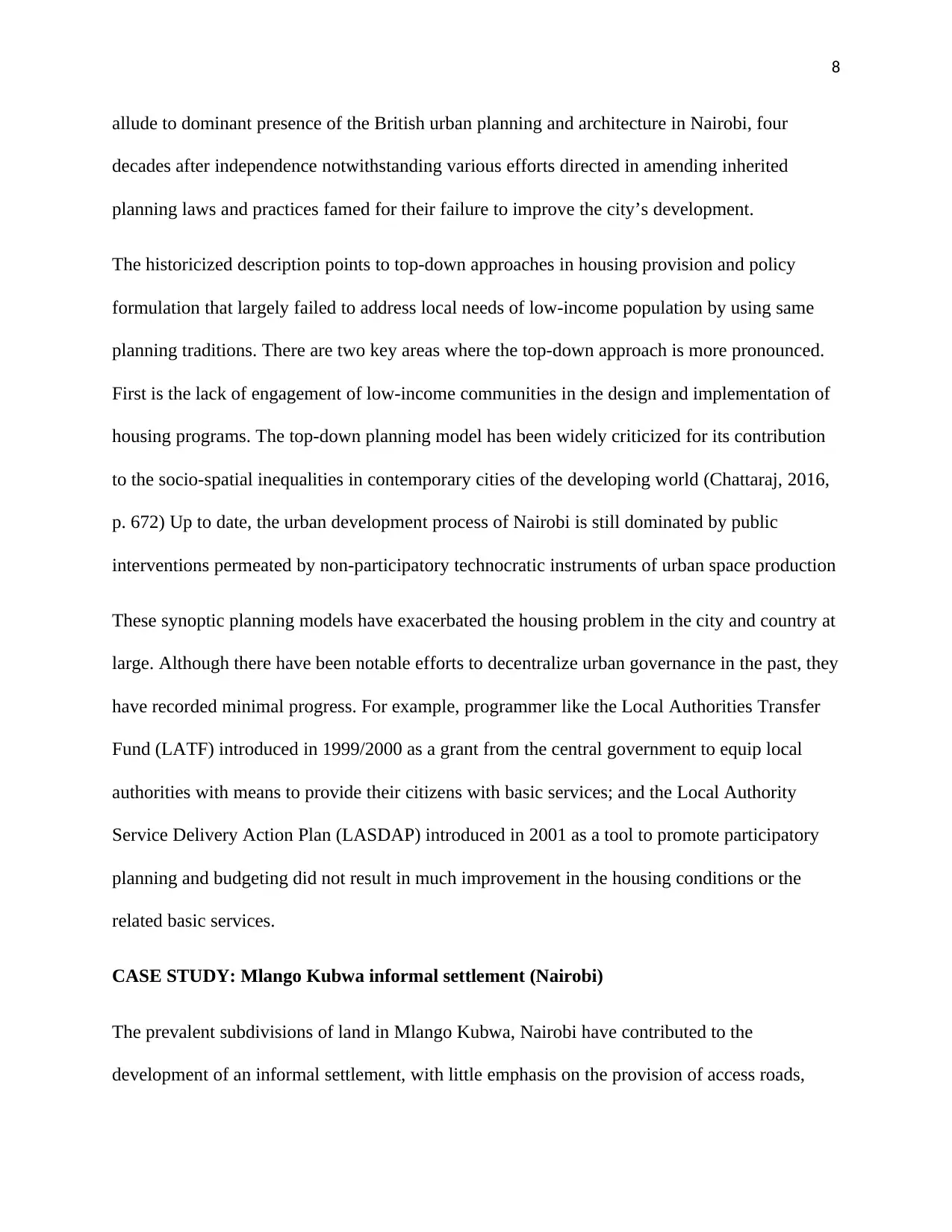
8
allude to dominant presence of the British urban planning and architecture in Nairobi, four
decades after independence notwithstanding various efforts directed in amending inherited
planning laws and practices famed for their failure to improve the city’s development.
The historicized description points to top-down approaches in housing provision and policy
formulation that largely failed to address local needs of low-income population by using same
planning traditions. There are two key areas where the top-down approach is more pronounced.
First is the lack of engagement of low-income communities in the design and implementation of
housing programs. The top-down planning model has been widely criticized for its contribution
to the socio-spatial inequalities in contemporary cities of the developing world (Chattaraj, 2016,
p. 672) Up to date, the urban development process of Nairobi is still dominated by public
interventions permeated by non-participatory technocratic instruments of urban space production
These synoptic planning models have exacerbated the housing problem in the city and country at
large. Although there have been notable efforts to decentralize urban governance in the past, they
have recorded minimal progress. For example, programmer like the Local Authorities Transfer
Fund (LATF) introduced in 1999/2000 as a grant from the central government to equip local
authorities with means to provide their citizens with basic services; and the Local Authority
Service Delivery Action Plan (LASDAP) introduced in 2001 as a tool to promote participatory
planning and budgeting did not result in much improvement in the housing conditions or the
related basic services.
CASE STUDY: Mlango Kubwa informal settlement (Nairobi)
The prevalent subdivisions of land in Mlango Kubwa, Nairobi have contributed to the
development of an informal settlement, with little emphasis on the provision of access roads,
allude to dominant presence of the British urban planning and architecture in Nairobi, four
decades after independence notwithstanding various efforts directed in amending inherited
planning laws and practices famed for their failure to improve the city’s development.
The historicized description points to top-down approaches in housing provision and policy
formulation that largely failed to address local needs of low-income population by using same
planning traditions. There are two key areas where the top-down approach is more pronounced.
First is the lack of engagement of low-income communities in the design and implementation of
housing programs. The top-down planning model has been widely criticized for its contribution
to the socio-spatial inequalities in contemporary cities of the developing world (Chattaraj, 2016,
p. 672) Up to date, the urban development process of Nairobi is still dominated by public
interventions permeated by non-participatory technocratic instruments of urban space production
These synoptic planning models have exacerbated the housing problem in the city and country at
large. Although there have been notable efforts to decentralize urban governance in the past, they
have recorded minimal progress. For example, programmer like the Local Authorities Transfer
Fund (LATF) introduced in 1999/2000 as a grant from the central government to equip local
authorities with means to provide their citizens with basic services; and the Local Authority
Service Delivery Action Plan (LASDAP) introduced in 2001 as a tool to promote participatory
planning and budgeting did not result in much improvement in the housing conditions or the
related basic services.
CASE STUDY: Mlango Kubwa informal settlement (Nairobi)
The prevalent subdivisions of land in Mlango Kubwa, Nairobi have contributed to the
development of an informal settlement, with little emphasis on the provision of access roads,
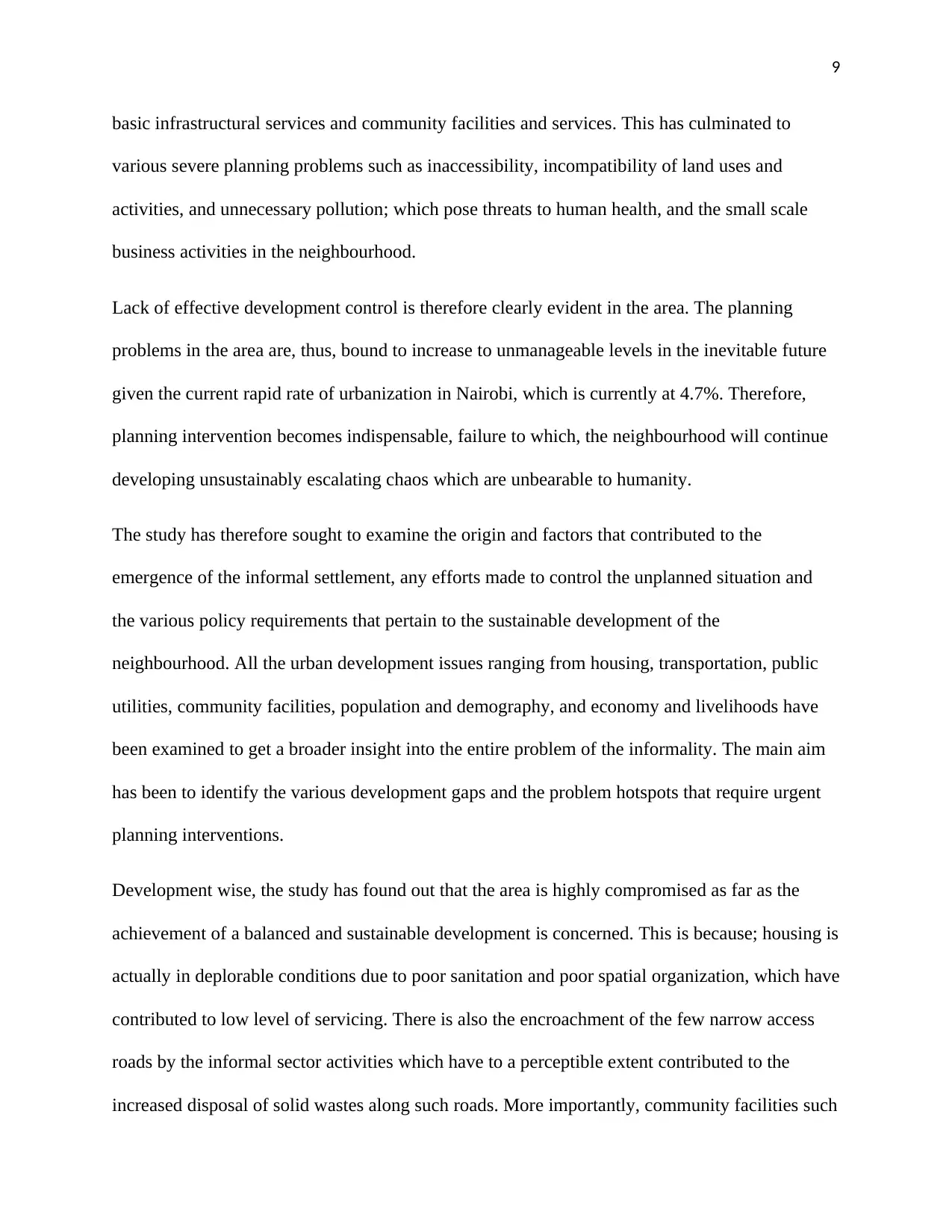
9
basic infrastructural services and community facilities and services. This has culminated to
various severe planning problems such as inaccessibility, incompatibility of land uses and
activities, and unnecessary pollution; which pose threats to human health, and the small scale
business activities in the neighbourhood.
Lack of effective development control is therefore clearly evident in the area. The planning
problems in the area are, thus, bound to increase to unmanageable levels in the inevitable future
given the current rapid rate of urbanization in Nairobi, which is currently at 4.7%. Therefore,
planning intervention becomes indispensable, failure to which, the neighbourhood will continue
developing unsustainably escalating chaos which are unbearable to humanity.
The study has therefore sought to examine the origin and factors that contributed to the
emergence of the informal settlement, any efforts made to control the unplanned situation and
the various policy requirements that pertain to the sustainable development of the
neighbourhood. All the urban development issues ranging from housing, transportation, public
utilities, community facilities, population and demography, and economy and livelihoods have
been examined to get a broader insight into the entire problem of the informality. The main aim
has been to identify the various development gaps and the problem hotspots that require urgent
planning interventions.
Development wise, the study has found out that the area is highly compromised as far as the
achievement of a balanced and sustainable development is concerned. This is because; housing is
actually in deplorable conditions due to poor sanitation and poor spatial organization, which have
contributed to low level of servicing. There is also the encroachment of the few narrow access
roads by the informal sector activities which have to a perceptible extent contributed to the
increased disposal of solid wastes along such roads. More importantly, community facilities such
basic infrastructural services and community facilities and services. This has culminated to
various severe planning problems such as inaccessibility, incompatibility of land uses and
activities, and unnecessary pollution; which pose threats to human health, and the small scale
business activities in the neighbourhood.
Lack of effective development control is therefore clearly evident in the area. The planning
problems in the area are, thus, bound to increase to unmanageable levels in the inevitable future
given the current rapid rate of urbanization in Nairobi, which is currently at 4.7%. Therefore,
planning intervention becomes indispensable, failure to which, the neighbourhood will continue
developing unsustainably escalating chaos which are unbearable to humanity.
The study has therefore sought to examine the origin and factors that contributed to the
emergence of the informal settlement, any efforts made to control the unplanned situation and
the various policy requirements that pertain to the sustainable development of the
neighbourhood. All the urban development issues ranging from housing, transportation, public
utilities, community facilities, population and demography, and economy and livelihoods have
been examined to get a broader insight into the entire problem of the informality. The main aim
has been to identify the various development gaps and the problem hotspots that require urgent
planning interventions.
Development wise, the study has found out that the area is highly compromised as far as the
achievement of a balanced and sustainable development is concerned. This is because; housing is
actually in deplorable conditions due to poor sanitation and poor spatial organization, which have
contributed to low level of servicing. There is also the encroachment of the few narrow access
roads by the informal sector activities which have to a perceptible extent contributed to the
increased disposal of solid wastes along such roads. More importantly, community facilities such
⊘ This is a preview!⊘
Do you want full access?
Subscribe today to unlock all pages.

Trusted by 1+ million students worldwide
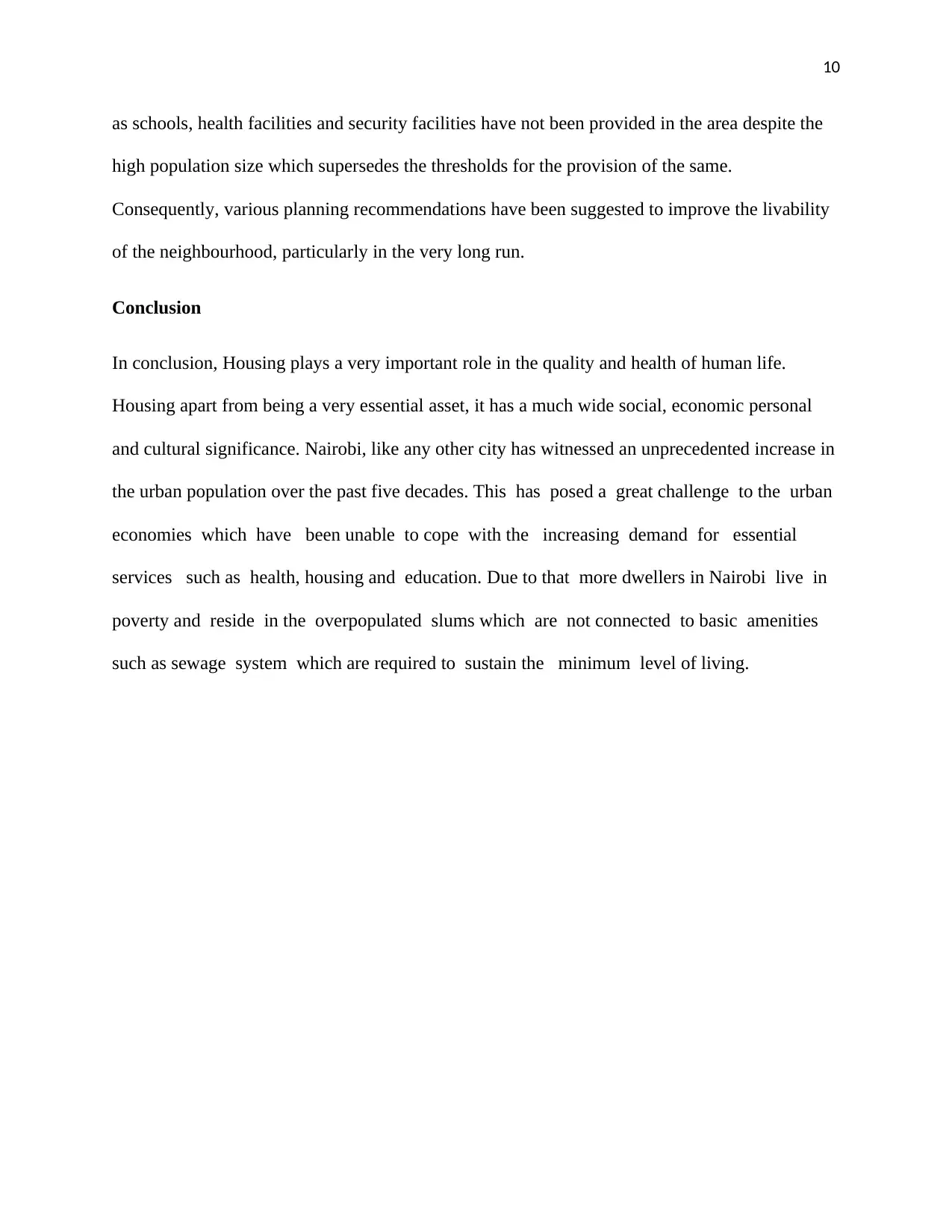
10
as schools, health facilities and security facilities have not been provided in the area despite the
high population size which supersedes the thresholds for the provision of the same.
Consequently, various planning recommendations have been suggested to improve the livability
of the neighbourhood, particularly in the very long run.
Conclusion
In conclusion, Housing plays a very important role in the quality and health of human life.
Housing apart from being a very essential asset, it has a much wide social, economic personal
and cultural significance. Nairobi, like any other city has witnessed an unprecedented increase in
the urban population over the past five decades. This has posed a great challenge to the urban
economies which have been unable to cope with the increasing demand for essential
services such as health, housing and education. Due to that more dwellers in Nairobi live in
poverty and reside in the overpopulated slums which are not connected to basic amenities
such as sewage system which are required to sustain the minimum level of living.
as schools, health facilities and security facilities have not been provided in the area despite the
high population size which supersedes the thresholds for the provision of the same.
Consequently, various planning recommendations have been suggested to improve the livability
of the neighbourhood, particularly in the very long run.
Conclusion
In conclusion, Housing plays a very important role in the quality and health of human life.
Housing apart from being a very essential asset, it has a much wide social, economic personal
and cultural significance. Nairobi, like any other city has witnessed an unprecedented increase in
the urban population over the past five decades. This has posed a great challenge to the urban
economies which have been unable to cope with the increasing demand for essential
services such as health, housing and education. Due to that more dwellers in Nairobi live in
poverty and reside in the overpopulated slums which are not connected to basic amenities
such as sewage system which are required to sustain the minimum level of living.
Paraphrase This Document
Need a fresh take? Get an instant paraphrase of this document with our AI Paraphraser
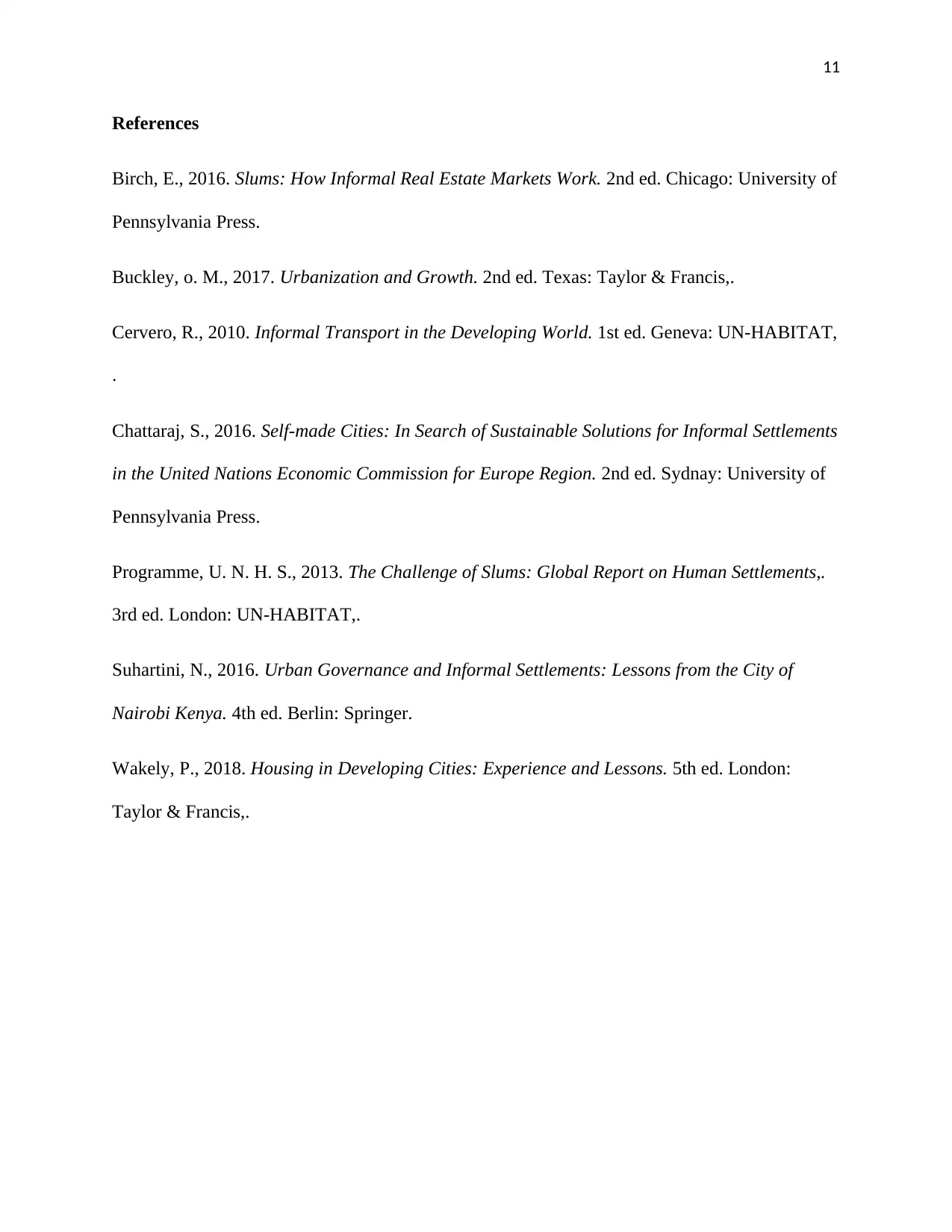
11
References
Birch, E., 2016. Slums: How Informal Real Estate Markets Work. 2nd ed. Chicago: University of
Pennsylvania Press.
Buckley, o. M., 2017. Urbanization and Growth. 2nd ed. Texas: Taylor & Francis,.
Cervero, R., 2010. Informal Transport in the Developing World. 1st ed. Geneva: UN-HABITAT,
.
Chattaraj, S., 2016. Self-made Cities: In Search of Sustainable Solutions for Informal Settlements
in the United Nations Economic Commission for Europe Region. 2nd ed. Sydnay: University of
Pennsylvania Press.
Programme, U. N. H. S., 2013. The Challenge of Slums: Global Report on Human Settlements,.
3rd ed. London: UN-HABITAT,.
Suhartini, N., 2016. Urban Governance and Informal Settlements: Lessons from the City of
Nairobi Kenya. 4th ed. Berlin: Springer.
Wakely, P., 2018. Housing in Developing Cities: Experience and Lessons. 5th ed. London:
Taylor & Francis,.
References
Birch, E., 2016. Slums: How Informal Real Estate Markets Work. 2nd ed. Chicago: University of
Pennsylvania Press.
Buckley, o. M., 2017. Urbanization and Growth. 2nd ed. Texas: Taylor & Francis,.
Cervero, R., 2010. Informal Transport in the Developing World. 1st ed. Geneva: UN-HABITAT,
.
Chattaraj, S., 2016. Self-made Cities: In Search of Sustainable Solutions for Informal Settlements
in the United Nations Economic Commission for Europe Region. 2nd ed. Sydnay: University of
Pennsylvania Press.
Programme, U. N. H. S., 2013. The Challenge of Slums: Global Report on Human Settlements,.
3rd ed. London: UN-HABITAT,.
Suhartini, N., 2016. Urban Governance and Informal Settlements: Lessons from the City of
Nairobi Kenya. 4th ed. Berlin: Springer.
Wakely, P., 2018. Housing in Developing Cities: Experience and Lessons. 5th ed. London:
Taylor & Francis,.

12
⊘ This is a preview!⊘
Do you want full access?
Subscribe today to unlock all pages.

Trusted by 1+ million students worldwide
1 out of 12
Related Documents
Your All-in-One AI-Powered Toolkit for Academic Success.
+13062052269
info@desklib.com
Available 24*7 on WhatsApp / Email
![[object Object]](/_next/static/media/star-bottom.7253800d.svg)
Unlock your academic potential
Copyright © 2020–2025 A2Z Services. All Rights Reserved. Developed and managed by ZUCOL.





